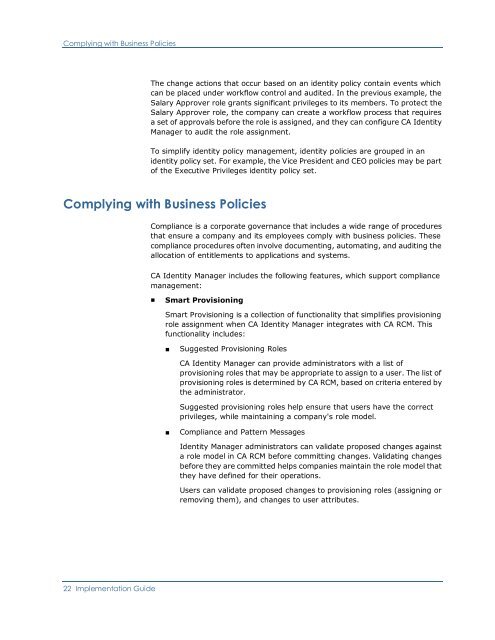CA Identity Manager Implementation Guide - CA Technologies
CA Identity Manager Implementation Guide - CA Technologies
CA Identity Manager Implementation Guide - CA Technologies
- No tags were found...
You also want an ePaper? Increase the reach of your titles
YUMPU automatically turns print PDFs into web optimized ePapers that Google loves.
Complying with Business PoliciesThe change actions that occur based on an identity policy contain events whichcan be placed under workflow control and audited. In the previous example, theSalary Approver role grants significant privileges to its members. To protect theSalary Approver role, the company can create a workflow process that requiresa set of approvals before the role is assigned, and they can configure <strong>CA</strong> <strong>Identity</strong><strong>Manager</strong> to audit the role assignment.To simplify identity policy management, identity policies are grouped in anidentity policy set. For example, the Vice President and CEO policies may be partof the Executive Privileges identity policy set.Complying with Business PoliciesCompliance is a corporate governance that includes a wide range of proceduresthat ensure a company and its employees comply with business policies. Thesecompliance procedures often involve documenting, automating, and auditing theallocation of entitlements to applications and systems.<strong>CA</strong> <strong>Identity</strong> <strong>Manager</strong> includes the following features, which support compliancemanagement:■Smart ProvisioningSmart Provisioning is a collection of functionality that simplifies provisioningrole assignment when <strong>CA</strong> <strong>Identity</strong> <strong>Manager</strong> integrates with <strong>CA</strong> RCM. Thisfunctionality includes:■Suggested Provisioning Roles<strong>CA</strong> <strong>Identity</strong> <strong>Manager</strong> can provide administrators with a list ofprovisioning roles that may be appropriate to assign to a user. The list ofprovisioning roles is determined by <strong>CA</strong> RCM, based on criteria entered bythe administrator.Suggested provisioning roles help ensure that users have the correctprivileges, while maintaining a company's role model.■Compliance and Pattern Messages<strong>Identity</strong> <strong>Manager</strong> administrators can validate proposed changes againsta role model in <strong>CA</strong> RCM before committing changes. Validating changesbefore they are committed helps companies maintain the role model thatthey have defined for their operations.Users can validate proposed changes to provisioning roles (assigning orremoving them), and changes to user attributes.22 <strong>Implementation</strong> <strong>Guide</strong>
















